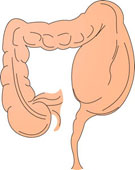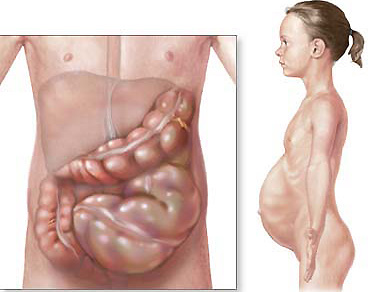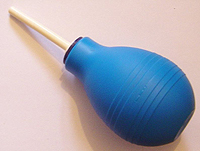What is mega- and dolichocolone? As manifests itself and how this disease is treated?
Read in this article.
Content
Mega- and Dolichokolon
Dolichokolon – it is the elongation of the colon, and megalolon – Her expansion. In the case when similar changes affect only the sigmoid colon of the colon, the term mega-/ dolichosigma is used.
 Dolichokolon – It is a congenital lengthening of the colon with the underdevelopment of the nervous wall of the wall, followed by the addition and progression of organic changes of its wall and mesentery due to the damage to intramural plexuses, violation of the function and development of inflammatory processes.
Dolichokolon – It is a congenital lengthening of the colon with the underdevelopment of the nervous wall of the wall, followed by the addition and progression of organic changes of its wall and mesentery due to the damage to intramural plexuses, violation of the function and development of inflammatory processes.
A number of researchers believe that the dolichocolone can only be congenital pathology. Other authors believe that the dolichocolone can be acquired by the state with the most diverse reasons. For example, cases are described when the abuse of the voids and laxatives led to the elongation of the colon, and in the elderly, the dolichocolone is associated with a violation of metabolic processes in the colon wall. Congenital dolichosigma contributes to constipation, and constipation – Development of dolichosigma due to the formation of mechanical obstacles to promote the contents of the intestine due to its atony and «Torture». As a result, a vicious circle occurs.
In case of maintaining the normal diameter of the lumen and the absence of changes in the muscular layer, the elongation of the colon and her mesentery is not accompanied by violations of the intestinal function. With a good permitting function, Dolicholone and Dolichosigma do not have clinical manifestations. In case of violation of intestines, meteorism develops meteorism, abdominal pain, constipation. During inspection, the bloating is noteworthy, when palpation – The pain of segments of the colon, especially sigmoid.
The diagnosis is set by irrigoscopy or colonoscopy. The intestinal passage is estimated by x-ray or isotopic markers.
Treatment is aimed at eliminating constipation. Rarely, in the case of persistent long constipation, surgical treatment (resection of the elongated part of the intestine).
Megacolon and megarctum are used when the diameter of the rectosigmoid department or the downstream is 6.5 cm, the rising intestine on the radiograph – 8 cm or when the diameter of the blind intestine is more than 12 cm. Megacolon can be a symptom of diseases such as congenital (Giršprung disease) and idiopathic megolone (arising from chronic constipation of any origin), intestinal pseudocution (manifestation of pronounced disorders of the digestive tract). Toxic megaColon as a severe complication of inflammatory diseases of the intestine and infectious colitis in this article is not considered.
Acquired Megacolon can provoke constipation arising for various reasons. The conclusion about the presence of the acquired Megacolon can be made in the event that the extension of the colon was not observed with the earlier inspections. The most common cause of the acquired Megacolon is atonic constipation, which are observed both in young and old age. In children, this form of megacolon is easily confused with the congenital extension of the colon (Girshprung disease).
The colon is capable of expanding, which means it is possible to form the acquired Megalon. As will be shown below, even in the absence of mechanical intestinal obstruction, the colon can be expanded sometimes to frightening sizes. Proof of the fact that the expansion is a typical pathophysiological reaction of the colon, also serves as a toxic megalon syndrome. If it was previously believed that the expansion of the colon was observed only with non-specific ulcerative colitis, now it became clear that the Crohn's disease, amoebic, pseudomambranous and specific infectious colitis can also cause it a dangerous complication.
Acquired Megacolon and Megaretum
The best proof of the acquired Megacolon in the patient is a radiographic evidence that the thick intestine has not been expanded. Unfortunately, such information is not always available, so the megacolon is considered acquired, if it is not possible to detect any congenital anomalies or constipation appeared later than in infant age. When diagnosing the acquired Megacolon, it should be found out.
 Presents certain interest terminology. Megacolon means the expansion of the colon caused by the non-mechanical cause. In this case, the rectum has normal sizes. Megarecuum suggests that the rectal reservoir is increased, sometimes significantly. Perhaps the combination of megacolon and megactum, but not all patients with megactum suffer from megacolon, and vice versa. In this regard, it is important to accurately diagnose, t. To. Therapeutic and surgical treatment methods are varying depending on which integrated integrated. Acquired Megaretum and Megalon, strictly speaking, are various diseases. It is also important to note that these terms do not belong to the lengthening of the colon (Dolichocolone), which is often determined in patients with chronic constipation, but maybe without them.
Presents certain interest terminology. Megacolon means the expansion of the colon caused by the non-mechanical cause. In this case, the rectum has normal sizes. Megarecuum suggests that the rectal reservoir is increased, sometimes significantly. Perhaps the combination of megacolon and megactum, but not all patients with megactum suffer from megacolon, and vice versa. In this regard, it is important to accurately diagnose, t. To. Therapeutic and surgical treatment methods are varying depending on which integrated integrated. Acquired Megaretum and Megalon, strictly speaking, are various diseases. It is also important to note that these terms do not belong to the lengthening of the colon (Dolichocolone), which is often determined in patients with chronic constipation, but maybe without them.
Causes. Although the exact reason that provokes the occurrence of the acquired Megacolon and Megarectum is not known, none of the segments of the colon is anglingly. This is the situation – A kind of feature distinguishing congenital and acquired forms of illness. Although the myopathy of the digestive tract may be the cause of the megalon, in patients with this pathology, the peristaltic activity of the stomach and small intestine is not always disturbed. On the other hand, patients with chronic pseudo-processing of the digestive tract, in T. C. stomach and small intestine, can have a slow motion peristaltics, but often do not have the expansion of thick and rectum.
Manifestations. If Girshprung's disease is mainly striking boys, then the acquired Megacolon is found equally often in men and women. The general condition of patients with megacolon is significantly better than in patients suffering from Giršsprung disease.
Among adult patients with megacolon and megactum, two groups can be distinguished depending on the timing of the beginning of clinical manifestations. Some begin to suffer from constipation in early childhood (usually before reaching 1 year). Other symptoms are developing after 10 years or even in a mature age. In the first group of constipation, the packaging of feces of linen appear in early childhood; In the second group, constipation and abdominal pain dominate, but the laundry stacked is not marked. If the symptoms began to appear from early childhood, the acquired Megacolon is considered organic, because there is no relevant psychopathology (similar to changes in the psyche in irritable syndrome). On the other hand, the chronic acquired Megacolon, whose manifestations begin later, sometimes occurs when the child's negativity is due to the deterioration of the act of defecation at that time when he is involved in using the pot or toilet.
The dominant symptom of both forms of Megacolon are constipation: whole weeks can take place between independent defecates. In some patients, fecal masses compressable in the rectum are easily palpable at the bottom of the abdomen. The solid mass of excrement is located, sometimes quite a long time, immediately above the anorectal ring, which leads to a wide disclosure of the anus, since the function of the internal anal sphincter is suppressed by the chronic expansion of the rectum. Some patients with a megactum dominant symptom may not constitution, but incontinence of feces (due to the revelation of the rectum).
Diagnostics. The main difficulty consists in the differential diagnosis of congenital and acquired Megacolon, for which complaints, history and physical research data is usually not enough and radiological and endoscopic research is necessary.
Manometric data of the anorectal region make it possible to estimate the presence of rectal reflex, which also helps the differential diagnosis of acquired and congenital megalon. The presence of a preserved reflex indicates the existence of intact ganglia, t. E. about the absence of gyrolsprung disease. However, if there is no such reflex, it does not mean that the patient suffers from Giršsprung disease. Sometimes the reflex is difficult to identify due to chronic braking by the dense fecal masses of the function of the internal anal sphincter. If the reflex is missing, and the overflows of the intestine feces are not observed, the biopsy of the muscular wall of the rectum above the anorectal ring should be carried out. In patients with diffuse megacolan, there is usually a launch of the passage from the colon to a straight. On the other hand, patients with megacolon or megactum with an undisturbed passage of fecal masses suffer from uncomplicated constipation, which do not need surgical treatment.
The passage of the contents on the colt and rectakes is convenient to evaluate using the administration of the X-ray. The patient swallows the same number of x-ray tags at the same time of the day for three days in a row, and every day labels have a different form. Then make overview radiographs of the abdominal cavity at the same time day on the fourth and seventh days. When comparing results with the norm, you can easily conclude on the status of the passage in the colon in a particular patient, and if this passage is slowed down, you can evaluate, in which segment of the colon it happens. If the promotion of the content is slowed down, then make a conclusion about constipation, but not about megacolone or megarektum, t. To. constipation can be caused by other numerous reasons. Data on the intestinal passage can also be clarified using radio communications using gamma chamber.
Treatment. The goal of the drug treatment of megacolon or megarektum is to achieve timely exemption of the intestine from the feces and the prevention of intestinal obstruction. If it is necessary to exemplate the intestine from wheelcase concreters, it is sometimes used by a manual method under anesthesia, use purification enemas and laxatives (whenever possible avoiding annoying laxatives). Patients need to produce a deflexion reflex after meals.
If medical treatment is ineffective, then surgical interventions are used. The choice of an operation variant depends on the exact diagnosis and state of the motorcycle. For example, for patients with a megacolon and a slow passage of contents, the intestine is recommended by ileostomy or imposition of ileoanal anastomosis depending on the age, lifestyle and patient's physique. However, it should be borne in mind that after the imposition of ilektal anastomosis in some patients, constipation persists, especially if the violations of the pelvic bottom function were not eliminated. After this operation, patients usually restore the anus reaction to irritation, and they normally control the intestinal emptying mechanism. Ileostomy is more often used in older people.
For patients with a megacolon, but the normal diameter of the rectum and the mechanism of defecation, an ileorectostomy is considered to be a choice of selection operation, including patients with elderly. Patients with megactum, the colon of the normal diameter and disorders of the mechanism of defecation are subject to Duhamel operation or the imposition of a thick-body anal anastomosis. In the latter case, resection of the entire extended rectum is performed, which avoids the formation of powerful concrections in the cult of this intestine, often formed in patients after Duhamel surgery.
Acute Megacolon
 Acute Megolon is a complication of severe inflammatory bowel disease and infectious colitis. Sometimes acute megaColon develops in patients without preceding obvious diseases of the colon or mechanical intestinal obstruction. In this case, we are talking about the pseudo structure of the colon (Ogilvi syndrome). The causes of the acute megacolon can also be injury, operations on the organs of the abdominal cavity or pelvis, metabolic disorders (hypokalemia) or neurological diseases.
Acute Megolon is a complication of severe inflammatory bowel disease and infectious colitis. Sometimes acute megaColon develops in patients without preceding obvious diseases of the colon or mechanical intestinal obstruction. In this case, we are talking about the pseudo structure of the colon (Ogilvi syndrome). The causes of the acute megacolon can also be injury, operations on the organs of the abdominal cavity or pelvis, metabolic disorders (hypokalemia) or neurological diseases.
Causes. The exact reason for the acute pseudo-process of the colon is unknown. However, most patients point to spent on the eve of surgical interventions or injuries. Be that as it may, Oglvvi syndrome – An ideal example of the expansion of the colon in the absence of mechanical obstacles passage. Increased preparedness of the colon to expansion in response to physiological and pharmacological incentives – The basis of the pathogenesis of Ogylvi syndrome.
Manifestation. A typical patient with Oglvi syndrome is an elderly man who is in a state of reconvalues after surgery, made on the eve of a few days, and already hosting PER OS. His stomach will be much reduced, breathing is difficult, but the signs of peritonite and leukocytosis are not observed (at least at the early phase of the disease). The overview radiography of the abdominal cavity reveals a significant stretching of the colon due to the accumulation of gases. Usually the small intestine is not visible. Diameter of the blind intestine at this stage of the disease – 9-10 cm.
Treatment. Meal PER OS should be canceled, liquid to enter parenterally, install a nasogastric probe. Further is prescribed with a water-soluble contrast to eliminate mechanical intestinal obstruction and confirm the pseudo-structures. In confirmation of the diagnosis, a rectal decompression tube and enema is used, electrolyte violations are corrected (hypokalemia). With insufficient treatment efficacy, cisaprid, erythromycin, neostigmin are prescribed. Neostigmin is administered at a dose of 2.5 mg intravenously for 1-3 minutes. At this time, the patient must be connected to an electrocardiographic monitor, it is necessary to prepare atropine. Neostigmin will work in 2-20 minutes. The scheme can be repeated sequentially up to three times until a positive result is reached.
In the future, with the ineffectiveness of the described treatment and the diameter of the blind intestine, more than 11 cm conduct a colonoscopic decompression. Gases and liquid stools are continuously aspiring, but a small amount of air (or carbon dioxide) is supplied to the intestine. No need to reach a blind intestine to ensure sufficient decompression; The location of the endoscope at the right (hepatic) bending of the colon with aspiration of the proximally content is usually reduced pressure in the upstream. The decompression tube can be left, but its effectiveness is doubtful. Conduct radiological control. If the diameter of the blind intestine decreased, then the patient can be kept on the enema until the chair and gases begin to move away spontaneously. Although colonoscopic decompression is usually repeated, it turns out to be effective in 80% of cases, and the remaining 20% of patients need operational intervention.









